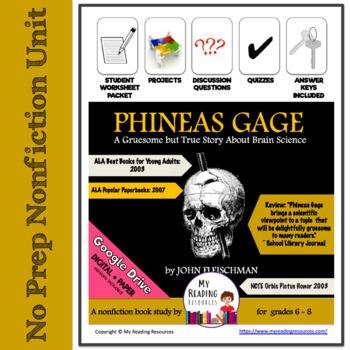Phineas Gage Nonfiction Book Study Guide -- Includes DIGITAL file options!
- PDF
- Google Apps™
- Easel Activity

What educators are saying
Description
This is a 120+ page Common Core aligned complete book study for the nonfiction text, Phineas Gage: A Gruesome but True Story About Brain Science by John Fleischman. This NO PREP book study teaching unit has everything that you will need to teach and assess the novel. The Table of Contents makes finding information quick and easy. ALL ANSWER KEYS ARE INCLUDED.
GO DIGITAL! Choose printed or paperless resources! The student packet, quizzes, and final exam are available as Google Drive™ files. A vocabulary and definitions list is also included to allow you to easily import into Flippity, Kahoot, Quizlet, etc. to create digital flashcards or word games.
Comments from buyers:
- “I absolutely love the comprehension questions. They address higher levels of Bloom's/deeper levels of DOK and require more than a basic "find it in the text" response.”
- “This resource has an abundance of activities that were very helpful during this unit!”
- “This made teaching the book an absolute breeze. I love that it's super low prep, but the questions are well-developed and require students to dig into the text. My students are currently working on their projects and I can't wait to see what they come up with.”
••••••••••••••••••••••••••••••••••••••••••••••••••••••••••••••••••••••••••••••••••••••••••••••••••••••••••
⮕⮕⮕Planning on purchasing multiple copies or additional resources?
⚡⚡⚡Save money with a Custom Bundle!
⮕⮕⮕Looking for a different title or a lesson targeted to a specific standard?
⚡⚡⚡Request a Product! We'll create a product specifically for you. There's no commitment to buy, but if you purchase within the first 24 hours, you'll receive the product at 50% off!
••••••••••••••••••••••••••••••••••••••••••••••••••••••••••••••••••••••••••••••••••••••••••••••••••••••••••
Included in this nonfiction book study:
Introductory and Informational Materials:
- Anticipation Guide (digital option)
- Teaching Notes
- Close Reading Strategies
- List of websites to extend learning, including a discussion with the author, a 3D tour of the brain, and a video teaching how to make a detailed drawing of a neuron
- CCSS Checklists for grades 6 - 8
Vocabulary Building Materials:
- Vocabulary Master List (digital option)
- “Mark My Words” Student Vocabulary Bookmark
Student Packet (digital option) (divided by chapter) featuring:
- Vocabulary
- Chapter Questions
- Focused Instruction on Synonyms/Antonyms, Greek and Latin Roots, and Figurative Language
- Discussion Questions
- Student Projects
Easy to Grade Assessments:
- Vocabulary Quiz (matching)
- (4) Section Quizzes (m/c) (digital option-Google Forms)
- 20-Question Comprehensive Quiz (m/c) (digital option-Google Forms)
- Rigorous Final Exam with Part A, Part B Questions (m/c) (digital option-Google Forms)
Common Core Standards utilized with this unit:
- R.I. 6.1, 6.2, 6.3, 6.4, 6.6, 6.8, 6.10
- R.I. 7.1, 7.2, 7.3, 7.4, 7.6, 7.8, 7.10
- R.I. 8.1, 8.2, 8.3, 8.4, 8.6, 8.8, 8.10
- L. 6.4, 6.4.a,b,c,d, 6.5, 6.5a
- L. 7.4, 7.4.a,b,c,d, 7.5, 7.5b, 7.6
- L. 8.4, 8.4.a,b,c,d, 8.5,8.5.a, 8.6
- S&L 6.1
- S&L 7.1
- S&L 8.1
Skills addressed in this book study guide include:
- identifying and explaining the meaning of figurative language
- synonyms and antonyms
- identifying supporting details
- describe setting
- connecting relevant subject matter
- Greek and Latin root words
- making inferences
- using evidence in the text to support arguments or opinions
- analyzing text
- summarize concepts
- identifying central ideas
- create a timeline (student project)
- compare and contrast two books (student projects)
Curriculum tie-ins:
- psychology
- the brain
- nervous system
_________________________
Just looking for assessments?
Purchase the section quizzes and crossword puzzles as a stand-alone product here.
Purchase the comprehensive quiz as a stand-alone product here.
Purchase the final exam as a stand-alone product here.
Looking for a student workbook?
Purchase the Student Packet as a stand-alone product here.
★ ★ ★ ★ ★ ★ ★ ★ ★ ★ ★ ★ ★ ★ ★ ★ ★ ★ ★ ★ ★ ★ ★ ★ ★ ★ ★ ★ ★ ★ ★ ★ ★ ★ ★ ★ ★
Questions or comments? Contact My Reading Resources directly at: myreadingresources@yahoo.com.
★ ★ ★ ★ ★ ★ ★ ★ ★ ★ ★ ★ ★ ★ ★ ★ ★ ★ ★ ★ ★ ★ ★ ★ ★ ★ ★ ★ ★ ★ ★ ★ ★ ★ ★ ★ ★
©My Reading Resources. All rights reserved. Purchase of this unit entitles the purchaser the right to reproduce the pages in limited quantities for classroom use only. Duplication for an entire school, an entire school system, Outschool, or commercial purposes is strictly forbidden without written permission from the publisher.
Copying any part of this product and placing it on the Internet in any publicly accessible (not password protected) form (even a personal/classroom website) is strictly forbidden and is a violation of the Digital Millennium Copyright Act (DMCA). These items can be picked up in a Google search and then shared worldwide.






